-
Posts
821 -
Joined
-
Last visited
-
Days Won
8
Content Type
Profiles
Forums
Blogs
Gallery
Events
Store
Posts posted by Markus
-
-
Samad Khan Momtaz os-Saltaneh, or Momtaz ol Saltaneh (1869–1955) (in Persian : صمد خان ممتاز السطنه) was an Iranian diplomat of the Qajar and Pahlavi dynasty era.
Son of Ali-Akbar Mokrem os-Saltaneh, brother of Esmail Momtaz od-Dowleh, and Momtaz Homayoun, Samad Khan Momtaz os-Saltaneh was born in 1869 in Tabriz (Iran) in an Azeri family. He first married an Iranian. His son Abdollah would later become a diplomat in Iran. In a second marriage to a Frenchwomam, he had two daughters; one of them married a lawyer, the other, a magistrate. He died in 1955 in Paris and was buried at Père-Lachaise cemetery. In March 1921, Samad Khan was elevated Prince by Ahmad Shah with the title of Royal Highness. He was Grand Officier de la Légion d'honneur.
In 1883, Samad Khan Momtaz os-Saltaneh was secretary of legation of Persia in Paris. He was embassy counsellor in St. Petersburg. He participated in the Nasser ed-Din Shah and then Mozaffar ed-Din Shah's travels to Europe. He was minister of Persia in Belgium and the Netherlands before being appointed Extraordinary and Plenipotentiary Minister in Paris in April 1905. He remained at this position until March 1926. He never returned to Iran and chose to live in Paris. He was recognized by the French government as counsellor of the Iranian embassy in Paris from March 5, 1946 to September 27, 1951. He was Prime Minister of Iran from 2 to 20 August 1918.
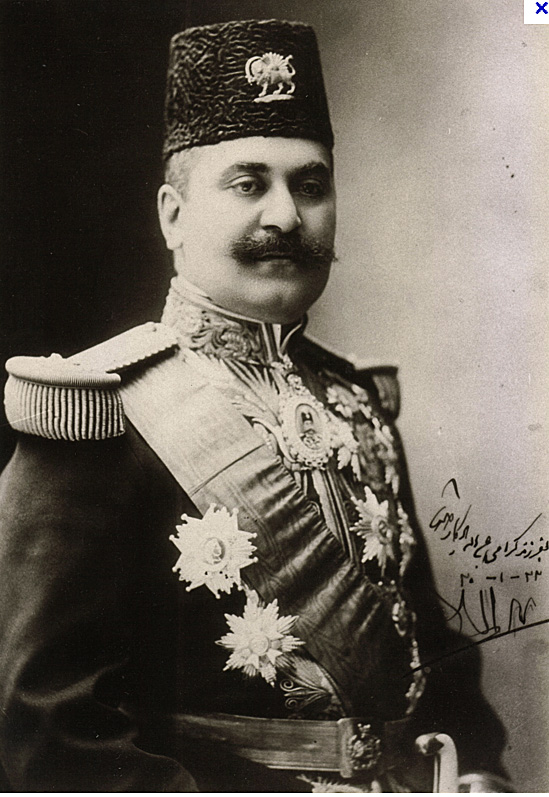 0
0 -
Mohammad Vali Khan Tonekaboni
Mohammad-Vali Khan, Sepahsālār-e Khalatbari Tonekāboni (Persian: محمدولیخان سپهسالار تنکابنی), also known as Sepahdar A'zam orSepahsālār-e A'zam-e Tonekāboni (Persian: سپهسالار اعظم تنکابنی), was the leader of the constitutionalist revolutionary forces from Iran's northern provinces of Gilan and Mazandaran and known as one of the greatest statesman and military commanders of Persian history as well as its wealthiest nobleman.
He served as colonel for ten years and became Minister of Post and Telegraph as well as Minister of Customs where he was in charge of all imports into and exports out of the Persian empire. Later he became Minister of Treasury where he was singlehandedly in charge of the entire country's coin issue. He also held the title of Minister of Defence and was Prime Minister for four terms. His highest military title was Commander in Chief. He was of the royal Khalatbari family.
As an ethnic Persian, Sepahsalar Khalatbari was the only leader who was able to restore security inside Persia by controlling the ethnic Turkomans inside the kingdom. He was called upon many times by not only the various sectors of the Persian government but also by the Russians to suppress the Turkomans. His enormous wealth with income estimated at US$2 million/year in the early 1900s (the equivalent of $530 million/year in 2000) allowed him to be the chief financier of the Persian Empire where he would use his property as collateral for loans the kingdom obtained from Russia and Britain.
In 1909 he was given the title Sepahdar Azam and was sent by then King Mohammad Ali Shah to crush the Turkoman Azerbaijani constitutionalist uprising in the northwest headed by Baqer Khan and Satter Khan. He arrived in Azerbaijan but refused to fight the constitutionalist forces deeming it "fratricide". Instead he returned to Tonekabon and due to his genius military skill and national democratic following became the leader of the constitutionalist and anti-royalist forces, the same forces he was sent to crush. As their new leader he first occupied the city of Qazvin and then marched onto Tehran.
During his march to Tehran the Russian foreign ministry in Saint Petersburg sent a telegram to the Russian Embassy in Tehran stating: "Please inform His Excellency Sepahdar Azam that if he and his army peacefully march on Tehran and then proceed to the house of Saad al Dowleh, then on the authority of this telegram, Sepahdar Azam and all his relatives and kin will be placed in the protection of the Tsarist government. The Tsarist government will pay him the equivalent of 6 million gold menats (approx US$500,000,000)."
Sepahdar Azam (Khalatbari Tonekaboni) wrote back "The Russian government believes I have done all this for my own personal gain. For Iran's freedom and independence I will sacrifice my life and property and those of my children."
Rejecting the Tsarist government's request, he continued his march and forced the royalists in Tehran to surrender. King Mohammad Ali Shah fled and sought refuge in the Russian embassy, then left Persia altogether. With no king or ruler, parliament passed a resolution to crown Khalatbari Tonekaboni the new King of Persia. He refused this title and instead urged a constitutional democracy. Eventually he accepted the title of Sepahsalar (Commander in Chief). Sepahsalar-e Khalatbari Tonekaboni became Minister of Defence in the first constitutionalist government that followed dethroning of King Mohammad Ali Shah Qajar in 1909. He subsequently became Prime Minister of Iran four times. As the largest property owner in Persia his noble "Khan" status allowed him to rule several fiefdoms in Gilan and Mazandarin provinces, including the city and regions surrounding Tonekabon.
Sepahsalar Khalatbari Tonekaboni continued to fight the religious clerics' attempts to create a theocracy as well as the ruling establishments attempts to continue a monarchy. He took frequent trips to France to learn the French system of representative democracy.
With the advent of the Pahlavi dynasty and the Reza Khans, imposed by the British in the 1920s, Sepahsalar Khalatbari Tonekaboni was placed under increased political pressure. Much of his property was seized by the new government in an attempt to control his wealth and his power. His favorite son, Colonel Ali Asghar Khan, was poisoned by agents of the Pahlavis. Sepahsalar had seen the new and first democratic constitutionalist government which he had created turn into an oppressive dictatorship plundered internally and controlled externally by the British.
On July 16, 1926, at the age of eighty, Sepahsalar Khalatbari Tonekaboni committed suicide. His last note, written to his eldest son Amir Asad, read: "Amir Asad, right away take my body to the shrine for cleansing and burial next to my son Saad al Dowleh. Do it now. For after living eighty years no mourning or tears are needed for me."
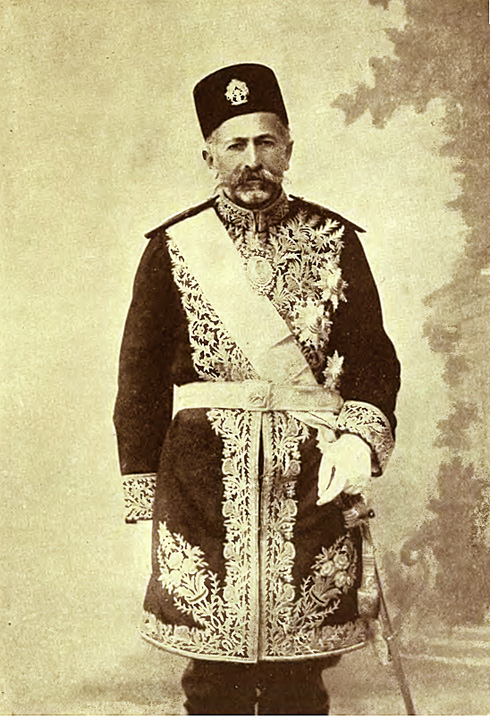 0
0 -
Does any one have any resources of jewelers that are capable of restoring enamel on medals? In Particular the green enamel rays on the Lion and Sun order. Seems like this is a real dying art form.
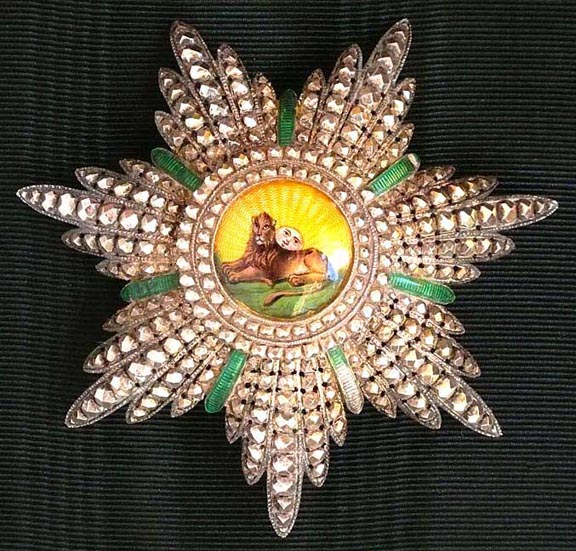 0
0 -
Post 16 in this thread http://gmic.co.uk/index.php/topic/53054-russians-and-their-lions/

Cheers,
Nick
Lol! I thought it looked familiar! I looked through this entire thread thinking I have seen it before but neglected to look through your Russian Lion and sun thread.
0 -
The back of Russian made commander badge.
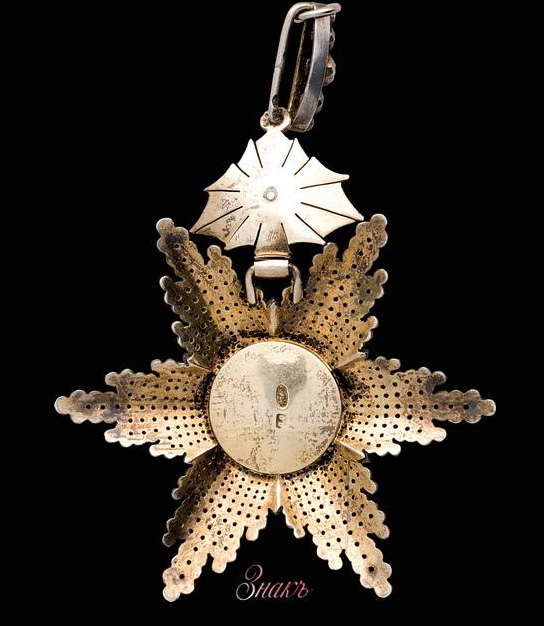 0
0 -
Here is another Russian beauty! A commander badge. Thanks Mitya for spotting this one.
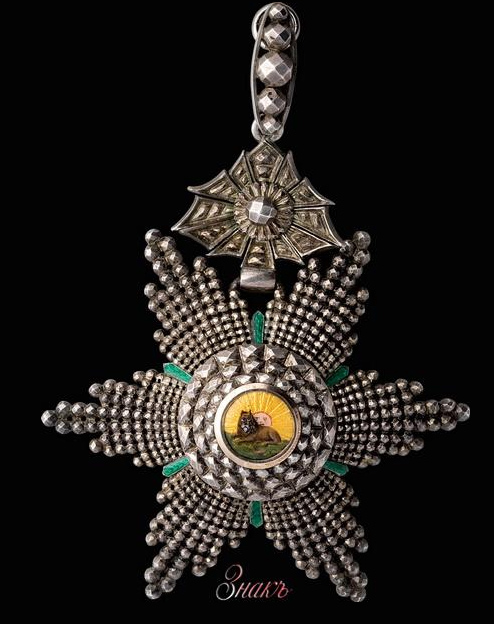 0
0 -
Andreas Thies' Aftab order back with hallmarks. Appears to have St. Petersburg city hallmark and maker initials ES. Seems like most of the Persian orders with jewels were made in Russia. Any one else have any ideas on which maker ES was? Thanks Mitya for the snap shots!
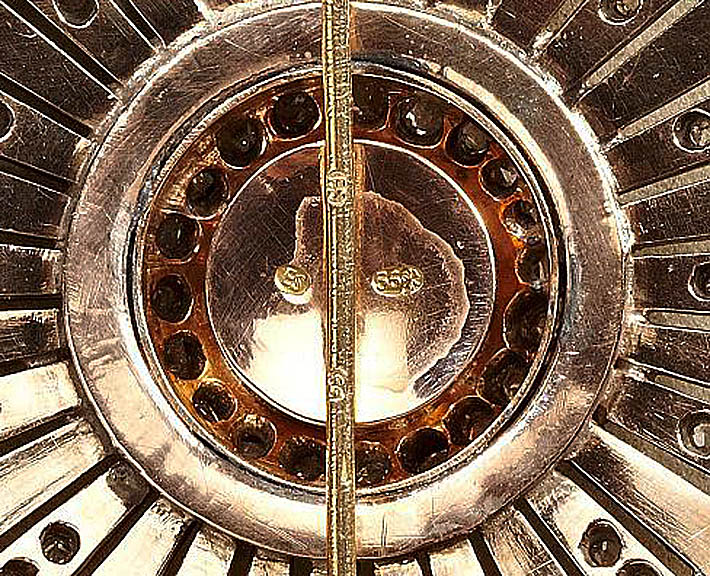 0
0 -
Nice photo mate!
But actually this photo was signed (most likely) on June 30, 1909.
In addition to 2nd class breast star of lion and sun order this handsome desperado has 2nd class breast star of noble Bukhara order.
And a HUGE watch on the left hand!
Regards,
Nick
P.S. Almost finished the new thread completely devoted to Cossack brigade

Yes that date of 1909 makes more sense given the history of Cossack Brigade and lion and sun order! It looks like he split the year date with the month date. I look forward to seeing your Cossack Brigade thread. No better example of Russian and Persian relations history.
Markus
0 -
This is a portrait of Colonel Vladimir Platonvitch Liakhov, a Russian who was a commander of the Persian Cossack Brigade during the rule of Mohammad Ali Shah. He gained considerable notoriety after shelling the Majlis of Iran and executed several constitutionalist leaders on June 24, 1908. As a sign of gratitude, Mohammad Ali Shah appointed him as the military Governor of Tehran. Note the large Persian Effigy medal pinned to his neck.
 0
0 -
Cossack soldier with Lion and Sun medal. Dated 1930 on photo.
The Persian Cossack Brigade was formed by Nasir al-Din Shah in 1879 using as a model the Caucasian Cossack regiments of the Imperial Russian Army, which had impressed him when travelling through southern Russia in 1878. Together with a Swedish officered and trained gendarmerie, the Cossack Brigade came to comprise the most effective military force available to the Iranian crown in the years prior to World War I.
In spite of its name the Brigade was never a genuine cossack force. Neither did it have the status of a guard unit. Late nineteenth century photographs show that Russian style uniforms were worn, in contrast to the indigenous dress of other Persian forces at the time. The rank and file of the Brigade were always Persian but until 1917 its commanders were Russian officers who were also employed in the Russian army, such as V. Liakhov. Such secondments were encouraged by the Imperial Russian Government who saw the Cossack Brigade as a means of extending Russian influence in a key area of international rivalry. After the October Revolution in 1917, many of these Russian officers left the country to join the "White" forces. The command of the Persian Cossack Division was subsequently transferred to Iranian officers. Most notable among these officers was General Reza Khan, who started his military career as a private soldier in the Cossack Brigade and rose through its ranks to become a Brigadier General.
http://en.wikipedia.org/wiki/Persian_Cossack_Brigade
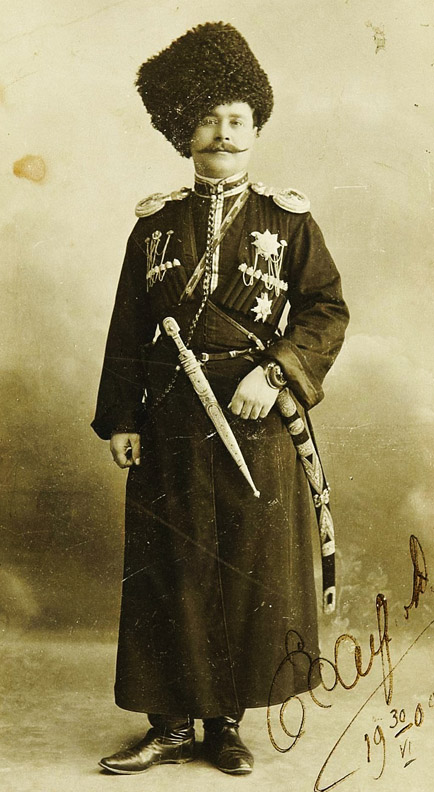 0
0 -
From Andreas Thies' latest auction catalog, a beautiful set of Aftab order up for auction.
Thanks Mitya and 922F for noting this auction.
 1
1 -
From Andreas Thies' latest auction catalog, a beautiful set of Aftab order up for auction.
Thanks Mitya and 922F for noting this auction.
 1
1 -
I wonder if this is all a mistake and that Queen Alexandra is actually wearing the ywo decorations in reverse?
Perhaps the semi-circular decoration is actually the badge and should be worn from the broad riband. It looks exactly like the sash badges presented to other recipients, except for the additional drop diamonds. When presented, it may have been in the box alongside the other insignia, but not actually attached to the riband.
Conversely, the 'special' diamond and enamel 'star' may have been pinned onto the bow of the riband by mistake. It is possible that because the star came with its own bow, the Queen was not quite sure where to pin it on. Clearly, with all its sharp points and raised surface it could not have been meant to be worn at the hip.
As I mentioned earlier, there was an older Turkish order with a star which ladies wore from a ribbon on the breast. But this too would not have been familiar to Europeans because it was never bestowed on foreigners.
Cheers,
James
I like your first theory James! These orders probably did not come with instructions and no one wanted to correct the Queen and have her lose face or embarrass her. It seems that since this was a photo session staged with the Shah, that she would have worn all of her Aftab order medals.
Markus
0 -
Markus,
Looks like you have found another first.
The second star, worn at the top in the north-east position nearest the arm appears to be entirely new to me.
The central medalion looks like a military standing lion, but the star seems to have blunt enamelled arms that I have never seen before.
Cheers,
James
Hi James,
Good observation! I tried to sharpen the photo detail but the highlights are pretty blown out and I wasn't able to salvage any more detail. It does appear to be a Lion and Sun image with a most unusual shaped badge. Will probably remain a mystery medal!
Markus
0 -
Hi Mitya you are a great scholar with an eye for detail! You are right! Here is the caption material posted in the back of the book that I should have read earlier:
"in December 1952' Queen Mary's Private Secretary Major John Wickman wrote to the Librarian at Windsor Castle, Sir Owen Moreshead, that the Queen " well remembers the occasion before her departure with Kng George V to India in 1904 when the Shah personally invested her with an Order all blazing with diamonds which looked rather like a rising sun."
0 -
An order of Aftab set with semi-circular and full circular breast star. Image courtesy of Babar.
This set was auctioned off in a Morton and Eden auction.
"[ Orders Decorations Medals ] Qajar, Order of Sun (Nishan-i Aftab), set of insignia, of European manufacture (probably French), late 19th century, in silver with gold and enamel centre, comprising semi- circular sash badge and circular breast star, the central enamelled female face with a circle of diamonds around, the rays of the badge and the star and the suspension of the badge all set with diamonds of varying size, the badge 70 x 60mm, star 70mm, contained in a Samiomamalek of Teheran red leather case, extremely fine and very rare . Estimate 6000-8000 Pounds.
Ex Bonham's Islamic Works of Art Auction, 29 April 1998 lot 230. The set is also featured in Qajar Portraits, Julian Raby, Azimuth editions, London 1999, figure 108 THE ORDER OF THE SUN was founded by Nasir-al-Din Shah during his first European Visit in 1873 and was originally awarded solely to queens regnant. The badge was worn on a pink riband with two narrow green stripes either side. Queen Victoria was one of the first recipients and the Order was later bestowed on Queen Alexandra in 1902 and the future Queen Mary in 1904. The badge from the latter is in the Royal Collection and was on display in the Windsor Castle exhibition of 1997. By the early 20th century it was extended to the wives of senior diplomats (compare the set awarded to Sabina Maissa, wife of Felice Maissa, Italian ambassador to Teheran from 1901-04, Sotheby's Geneva, 17 November 1994 lot 88, and the star awarded to Lady Lucia Marling, wife of Sir Charles Marling, British ambassador to Teheran during the Great War, Christie's, 2 October 1991, lot 189)."
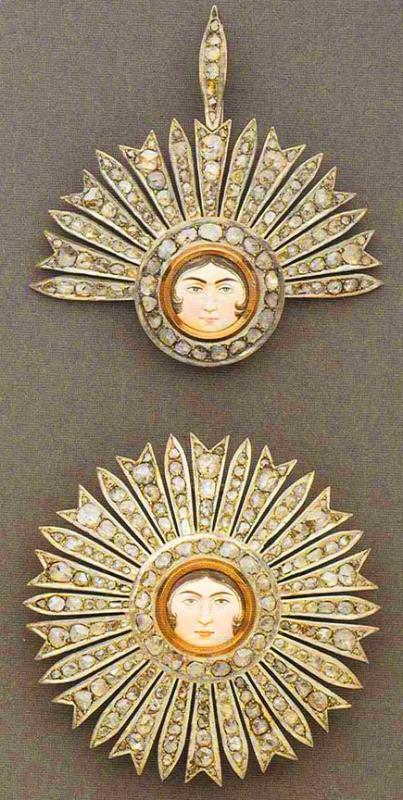 1
1 -
"The badge and star given to Queen Alexandra, which was depicted wearing during the Shah's visit in 1902, differ from those presented to Queen Mary in that there was only a semicircular star with pendant diamonds rather than a circular star and the badge is of diamonds and enamel rather than of just diamonds." From the book Royal Insignia, British And Foreign Orders Of Chivalry From The Royal Collection by Stephen Patterson.
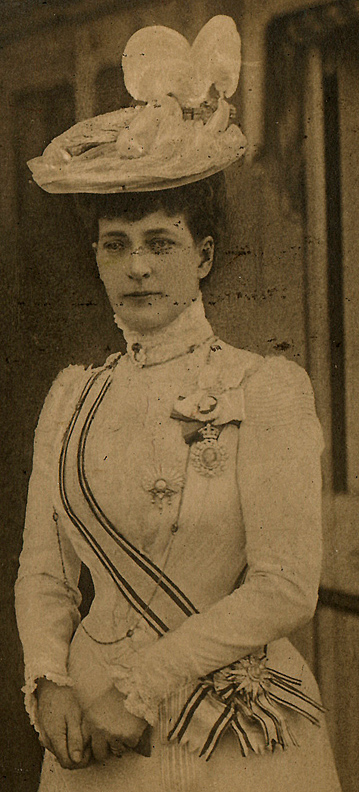 1
1 -
Queen Mary's Aftab order sash badge with diamonds, bestowed by Persia in 1904. From the book Royal Insignia, British And Foreign Orders Of Chivalry From The Royal Collection by Stephen Patterson.
"in December 1952' Queen Mary's Private Secretary Major John Wickman wrote to the Librarian at Windsor Castle, Sir Owen Moreshead, that the Queen " well remembers the occasion before her departure with Kng George V to India in 1904 when the Shah personally invested her with an Order all blazing with diamonds which looked rather like a rising sun."
 1
1 -
Soltan Morad Mirza Hessam Salanech was a son of Crown Prince Abbas Mirza and famous for recapturing Herat in 1856.
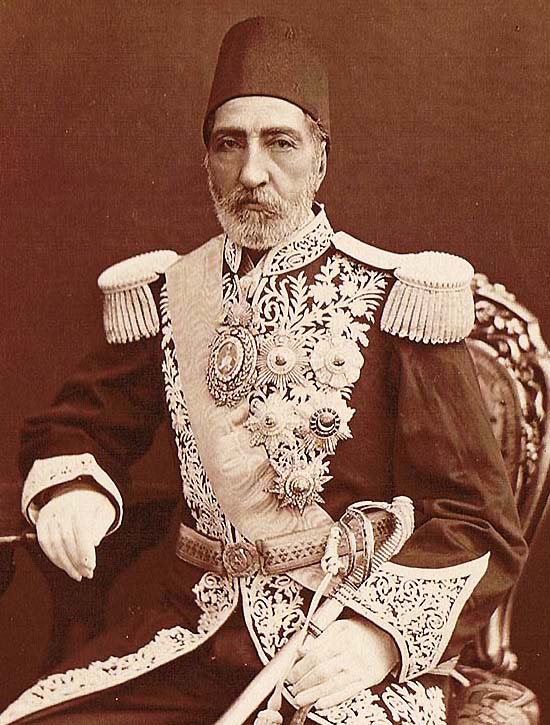 0
0 -
Are you sure that it is the later King Edward VII? Edward was quite an elderly man when he became king.
To my opinion, this is the later King George V, who was also named Prince of Wales before his coronation in 1910.
He gained the title Pince of Wales when his father Edward VIII was crowned in 1902.
The King of Spain is Alfonso XIII (1886-1941), who became king (in name) at birth (Infant King) and assumed Head of State in 1902.
see also: http://william-silvester.suite101.com/king-alfonso-xiii-a82132
Thanks Odulf for your help in sorting out the ID's on this postcard!
Markus
0 -
Picked up a postcard with Prince of Wales ( King George V, before his accession to throne) and King Alfonso VIII of Spain. Postcard has 1902 postmark. King Alfonso was born in 1886, so in this portrait, assuming the portrait was taken in 1902, he was 16 years old at the time. Thanks Odulf in helping me sort out that this was King George V.
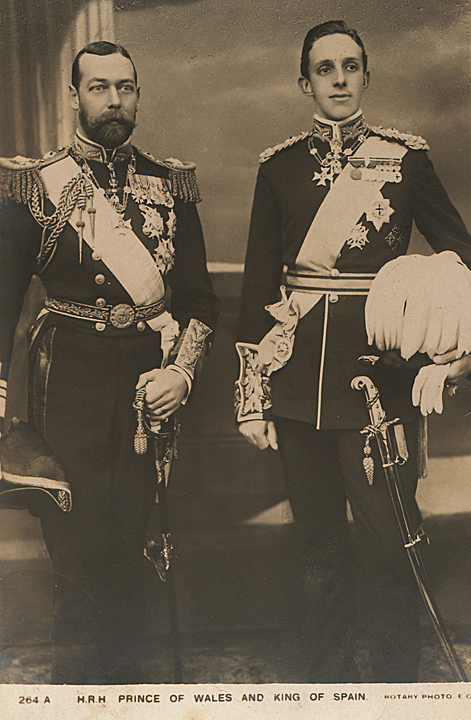 0
0 -
Hi James,
Yes this Alexandra sash and Aftab medal is a puzzle! I think maybe the Aftab medal was personalized with tear drop ornaments on the bottom. In looking at other Queen Alexandra's Jewelry, she really likes the tear shaped pearl pendants dangling from her necklaces. As to the star shaped badge pinned to her sash, it looks more like a Lion and Sun medal rather than an Aftab star. Now as regards to who is playing administrator of this thread, that is a whole other question, Lorenzo used to be moderator of the Middle East & Arab States forum until he was banned from GMIC
Markus
0 -
Here is a full body shot of Queen Alexandra that I tweaked and sharpened for maximum detail.
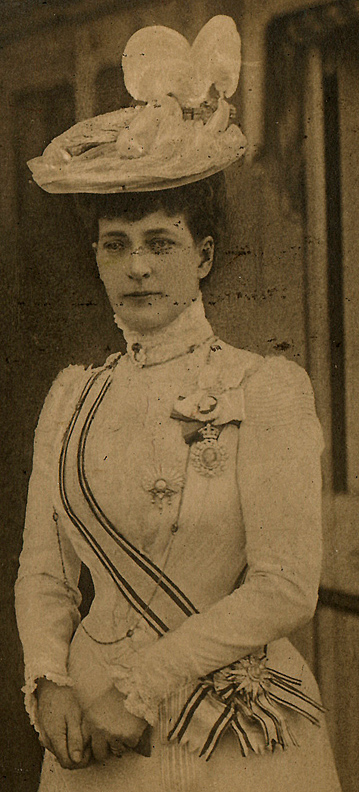 0
0 -
Mitya,
Here is a closeup of Alexandra's sash badge. The detail doesn't show that much other than a star shape.
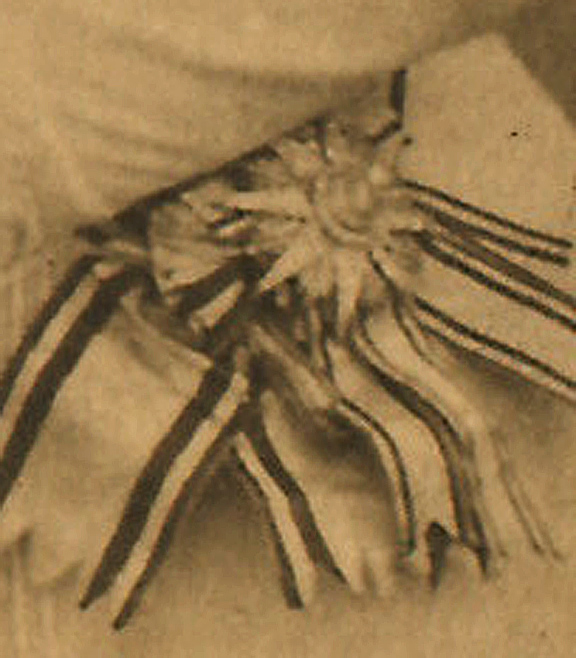 0
0




Persia - Order of the Lion and the Sun
in Middle East & Arab States
Posted
Another portrait of Samad Khan Momtaz os-Saltaneh.